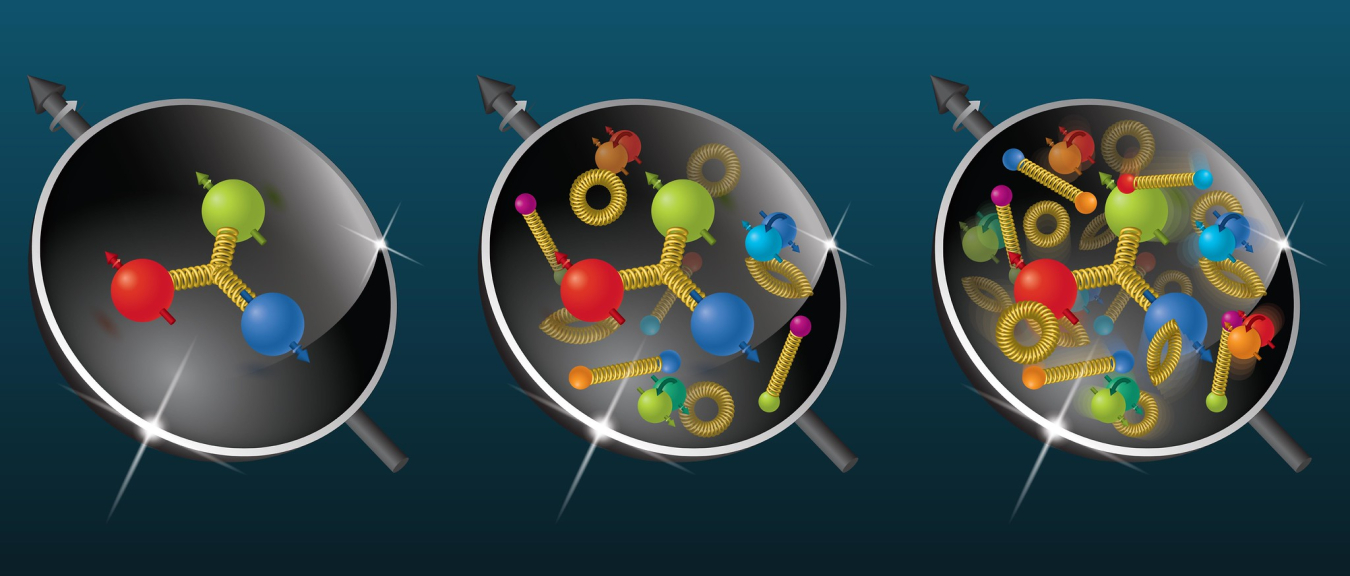Quantum chromodynamics (QCD) is the theory that explains how quarks and gluons interact through the strong force to produce larger subatomic particles such as protons and neutrons. Because protons and neutrons make up nuclei, QCD is an important part of scientists’ explanations of why there are atoms. That makes it key to understanding how all matter works.
Protons and neutrons are made of a soup of quarks and gluons. The quarks and gluons in this soup constantly interact. As they interact, they come in and out of existence, except for three remaining quarks (called valence quarks). These three remaining quarks have either a positive or negative electric charge. The combination of different quarks gives protons a positive electrical charge and neutrons a neutral electrical charge. This is covered by a theory called quantum electrodynamics (QED). QED explains the electromagnetic force that causes particles with a positive or negative charge to interact by exchanging photons. QED only addresses one variable—electrical charge. Electrical charge has only three broad values: positive, neutral, or negative.
In contrast to QED, QCD includes two more values. In addition to electrical charge, quarks also have two other values: “spin” and “color.”
Spin is a quantum number that has properties of normal classical spin (angular momentum like a top spinning), as well as some quantum mechanical properties involving the way that spin has specific possible values, not a range of possible values. For quarks, spin can be either up or down.
Quarks also come in one of three “colors” (also called “color charges”). The gluons that carry the strong force between quarks also have color. These aren’t real colors like we see, just a way to name quarks’ and gluons’ different variations. The quantum numbers for quark color are labeled red, green, and blue, and a quark can have a single unit of a color. There are also antiquarks, which come in three anticolors: antired, antigreen, and antiblue. Gluons come in certain combinations of the three colors and three anticolors. Gluons can also be colorless, if they have a combination of a color and its anticolor (red and antired cancel each other out). As quarks exchange gluons, the color of the quarks changes.
Why does QCD involve these so-called colors and anticolors at all? Scientists used to believe that quarks only had charge and spin. However, quarks cannot occupy the same space as another identical quark. (This is true for all the particles called fermions.) This is the subject of a principle in quantum mechanics called the “Pauli Exclusion Principle.” It means that two particles with the same quantum numbers cannot exist in the same space. When scientists found particles that broke this rule, it showed that apparently identical fermions must have quarks that differ in another way than only electrical charge and spin. That’s because with only one quantum number (spin) that has only two values (up or down), you can only have two particles in the same space. But protons and neutrons have three valence quarks. So scientists needed another way for quarks to differ.
Scientists called this third type of difference “color” or “color charges.” This color gives quarks and gluons another way they can differ. This difference allows gluons to link quarks together and thus form larger protons and neutrons. Protons and neutrons in turn combine to form atoms of every element except hydrogen (which has just one proton and no neutrons). This makes QCD an important part of understanding how quarks and gluons help to make up the matter in our Universe.
QCD Facts
- Quantum chromodynamics gets its name from words for color and change. “Chromo” comes from the Greek word for color, and “dynamics” refers to the way things move.
- Learn about the history of QCD.
- One of the Department of Energy Office of Science’s biggest projects now underway is construction of the Electron Ion Collider (EIC) at Brookhaven National Laboratory. The EIC will be a particle accelerator that collides electrons with protons and nuclei to produce three-dimensional snapshots of those particles to explore their quarks and gluons.
- Read some of the most important scientific papers about QCD.
DOE Office of Science Contributions to Quantum Chromodynamics
The Department of Energy has a long history of supporting research into fundamental particles and the forces that govern them, including QCD. Five of the six types of quarks, one type of lepton, and all three neutrinos were discovered at institutions that are now DOE national laboratories. Researchers supported by the DOE Office of Science, often in collaboration with scientists from around the world, have contributed to Nobel Prize-winning discoveries and measurements that refined the Standard Model.
Resources and Related Terms
- DOE Office of Science Office of High Energy Physics
- DOE Office of Science Office of Nuclear Physics
- Symmetry Magazine
- U.S. Particle Physics
- Science highlight: New Approach Merges Theoretical Fundamentals with Experimental Studies of the Proton’s Structure
- Science highlight: Scientists Discover Energy and Pressure Analogies Linking Hadrons, Superconductors, and Cosmic Expansion
- Science highlight: To Understand a Special Hadron, Researchers Turn to Supercomputers and Quantum Chromodynamics
Scientific terms can be confusing. DOE Explains offers straightforward explanations of key words and concepts in fundamental science. It also describes how these concepts apply to the work that the Department of Energy’s Office of Science conducts as it helps the United States excel in research across the scientific spectrum.


